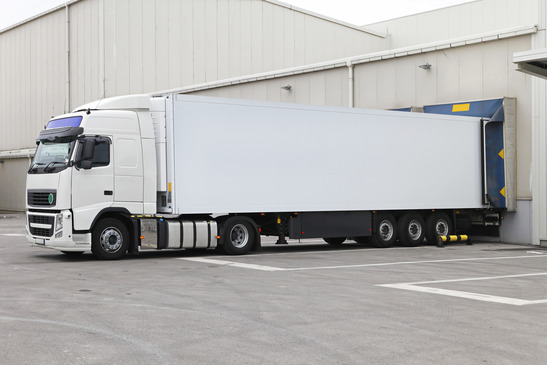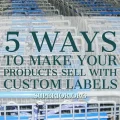Guest post by Marshall Englebrook – Superior Business Solutions’ Specialist
Information is King
 No matter where they originate the products and goods we consume must travel through a network of distribution channels throughout the country in order to reach our businesses and homes.
No matter where they originate the products and goods we consume must travel through a network of distribution channels throughout the country in order to reach our businesses and homes.
Organizing that distribution, solving the problems of distribution, is accomplished by correctly communicating information about the products, their origins and their destinations. That information must be portable and must travel securely and accurately. Information needs to be distributed as much as the goods themselves and labels in their many variations are a very important part of that information process.
What are the needs of the distribution network that a label solves? Let’s take apart the label itself first and consider its construction and then how the label layers provide solutions for the distribution network.
Basic Label Construction
When we look down on a typical label we can see the constructed layers as follows:
1. Data-on top of the label is information, bar codes, words, instructions and sometimes color. This data is preprinted by the label plant and/or added by the distribution center’s print devices.
2. Facestock-this is what the data is printed on and the actual type of stock will vary based on many variables.
3. Adhesive-the type of surface the label needs to adhere to: metal, wood, cold, hot, curved, flat, etc., along with the environmental conditions such as temperature and humidity, dictate the adhesives used.
4. Carrier-as the name implies, this layer carries the label until it is removed or peeled off for use.
Each of these layers can provide specific solutions for the needs in the distribution system.
Solutions Provided by the Label’s Layers of Construction
1. Data
Color Coding: Color coding products, locations, destinations, instructions or messages such as “Rush” or “Hold” can be accomplished with the label. The color can be variable as part of the label computer print process. Colors can be seen from a distance, increasing the speed when locating items and making decisions. Color is simple and quick to be recognized, reducing errors and increasing efficiencies.
Bar Coding: 2D bar codes such as QR Codes and PDF417 are dense with data, read vertically and horizontally, and take up less space than traditional horizontal codes such as Code 39. More data in a smaller space increases accuracy and productivity. PDF 417 codes are used to carry many details about a pallet such as weight, products, destination, age, serialized units contained on the pallet, etc. The greatly increased redundancy of a 2D code allows the code to continue to work in harsh environments. The code’s integrity can withstand forklift damage, weather, and industrial dirt. Scanning distance increases with 2D codes, helping warehouses scan smaller labels from greater distances and, in some cases, reducing the high cost of specialized stocks required for long distance scans.
2. Facestock
Synthetic Materials: Materials such as polypropylene and vinyl provide strong facestocks with greater durability than paper facestocks. Paper facestocks will tear if sharp objects come in contact with the label and will often be useless if exposed to water. This damage doesn’t allow the data on the label to be processed correctly creating errors, product returns, and lost productivity. In these harsher situations the more durable synthetic materials maintain the label’s integrity.
Security Features: Often distribution centers solve their customer’s needs, not just their own needs. Their retail customer may require security features that prevent loss issues such as fraudulent opening of a box to steal a product or switching labels for price swapping. Facestocks with filament threads can prevent cutting the box open, and security cuts in the Facestock can make a label self destruct when there is an attempt to switch prices.
3. Adhesive
Removable Adhesives: Many labeled surfaces in a distribution system are reused. Bins, totes, pallets, shelf locations, and cartons often require that a label be replaced. Removable adhesives allow a strong bond to the surface but are easily removed when the label needs to be replaced saving labor spent cleaning off label material.
Quick Tack Adhesives: Are often used with distribution center auto label applicators so the label will adhere to a product quickly and securely as they travel on a conveyer in an automated process. The pressure may be less with automated equipment than a person’s hand rubbing the label onto a box. The quick tack aggressive adhesives assure the labels stay applied.
4. Carrier
Printed Carrier: Usually the carrier is meant to temporarily hold the label until the label is used, and then the carrier is discarded. Laser label sheet carriers can now be preprinted with information at the label plant. A company logo, product information, special instructions for a return, or a thank you can be added under the label and revealed when it is removed.
Linerless Labels: Linerless label rolls feed through thermal printers that cut the label off at the required size for immediate application. The lack of a liner, or carrier, means less waste for a greener process. It’s safer too. No clutter on a warehouse floor where slick carrier material can contribute to injuries from a fall caused by slipping on the material.
For more information please be sure to reach out to Marshall HERE or contact us HERE.

 I strive to hear my customers, understand their need, and consult with them. And then I work very hard to source the best product or service solution worldwide that meets their unique requirement. You can connect with me on my page
I strive to hear my customers, understand their need, and consult with them. And then I work very hard to source the best product or service solution worldwide that meets their unique requirement. You can connect with me on my page 
